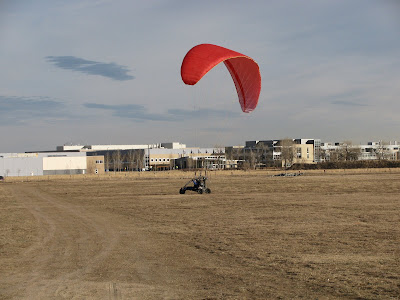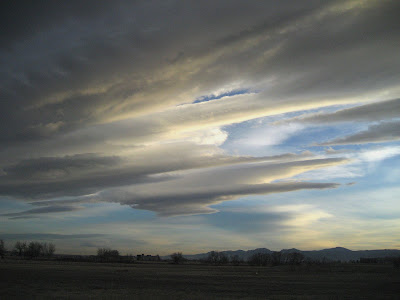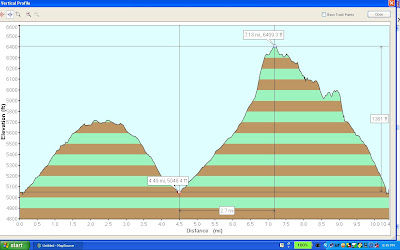The Rocky Mountain Thumper
is a very different kind of Paramotor
Two months ago I traded in the beloved Simonini and became the proud owner of a Briggs and Stratton Trike buggy. The 4 stroke power plant was designed and built by Terry Lutke and the Flexfoil Trike was developed for PPG by Chad Bastion.
The biggest downside to going 4 stroke is the lack of fun things to do while not flying. Having spent the last 4 years immersed in this sport, I was comfortable with all the the wonderful little things that are a normal part of a PPG pilots life. The nights spent in the garage replacing compression springs or driving to the airport after dinner to pick up AV Gas. If I wasn't searching the Internet for the best buy on Castrol TTS, I was waiting for the UPS man to deliver a 160 dollar starter sprocket. It seemed like I was either working on the maching or flying it. For every minute in the air there was an equal or greater amount of time occupied with the care and feeding of my 2 stroke paramotor. If it was blowing…no problem, I have a pull starter to rebuild.
Reliable
These days... things are different, because the heart of the "Thumper" is a Briggs & Stratton, twin V, 4 stroke motor. Thousands of these motors are built every year and the economy of scale makes it possible to produce a very affordable motor with excellent manufacturing tolerances and a beautiful fit and finish. They are designed to run 10,000 hours at peak horsepower, so it's not unreasonable to expect to fly hundreds of hours with nothing more than an annual check-up and oil change. When necessary, parts and expert service are readily available at the local lawnmower repair. Gone are countless hours tinkering with the machine. No mixing fuel, exotic tools or translating owners manuals. Now ,when it's too windy to fly, the best I can do is wish for better air. You still have to be ready for a "motor out" and have an emergency landing site within the glide slope but the reliability of this motor instills a confidence that allows for flights that would not have attempted before. Quiet
But.... When it is flyable, the thumper is always ready to go and the first thing you notice is the happy rumble of the Briggs & Stratton. On my first flight it was so quiet that I completely forgot the step where I put in the ear plugs and put on the helmet. I realized my mistake just as I was taking off and few seconds later so did everyone at the Salton Sea when my ball cap went through the prop. .....WAAK....ear protection is still necessary but with a four stroke power plant, noise is reduced by thirty percent or more. At cruise with the RPM's reduced it would not be impossible to use a cell phone.
Smooth
The next thing you notice is that the thumper doesn't suffer from the constant vibration that plagues two stroke motors. Its eerie, when the prop is in balance and the motor is running for level flight, its possible to forget all about the power plant and enjoy the ride. Occasionally you will find a node on the power band that sets up a harmonic vibration, but it's easy to bump up or down the RPMs to stay in the sweet spot. Flying a two stroke I was often ready to land at 45 minutes or an hour. Without the vibration I'm much more relaxed and feel like I'll be able to fly as long as the gas and weather will permit. Cross country flights of 100 miles or more are certainly possible.
Not for the con...Only one so far...There isn't the instant power you get with the Simonini. I won't be able to fly the contour of the surface like I used to. This year when I fly the dunes it will be from 30 feet above the tops instead of down in between the dunes. Flying the Thumper is going to require anticipating my power needs. It might be better with a different wing and it's going to be fun to try them out.



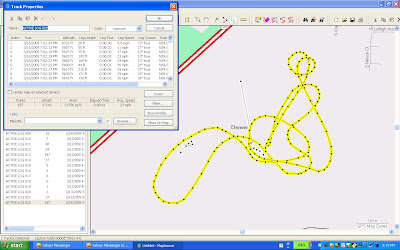

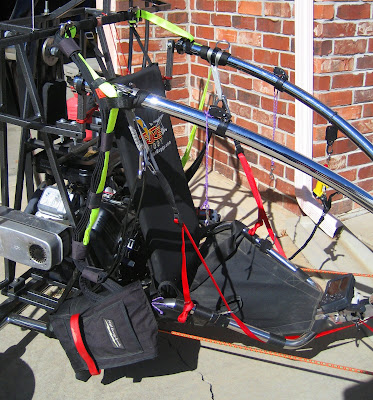



 On this first flight, I did not write the time down, butyou can see the time on the pictures of the GPS, so it tookapproximately one hour to climb to 8000 feet and 1:25 to climb to12,000 feet. I was still climbing at 12000 feet, but very slowly, andI was cold - I didn't wear enough layers to keep out the chill. Plus,I had not pitched the prop for maximum efficiency, at ground level itwas only 3400, and it got slower as I climbed. The motor ran beautifully the whole time, not even a hiccup. I amamazed by the four-stroker' s incredible reliability. I could get usedto this! Trouble is, when I fly a two-stroke again, I'll be wonderingwhen it will happen.... the inevitable motor-out. This motor is madeto run, and run, and RUN! I let it idle for a few minutes after Ireached 12K, then shut it down for the long glide back down. I reallyenjoyed the views from up high, there was snow on the nearby peaksnear San Bernadino, and I could see all the way to Tehachapi to thenorth and into the LA basin through the El Cajon Pass.
On this first flight, I did not write the time down, butyou can see the time on the pictures of the GPS, so it tookapproximately one hour to climb to 8000 feet and 1:25 to climb to12,000 feet. I was still climbing at 12000 feet, but very slowly, andI was cold - I didn't wear enough layers to keep out the chill. Plus,I had not pitched the prop for maximum efficiency, at ground level itwas only 3400, and it got slower as I climbed. The motor ran beautifully the whole time, not even a hiccup. I amamazed by the four-stroker' s incredible reliability. I could get usedto this! Trouble is, when I fly a two-stroke again, I'll be wonderingwhen it will happen.... the inevitable motor-out. This motor is madeto run, and run, and RUN! I let it idle for a few minutes after Ireached 12K, then shut it down for the long glide back down. I reallyenjoyed the views from up high, there was snow on the nearby peaksnear San Bernadino, and I could see all the way to Tehachapi to thenorth and into the LA basin through the El Cajon Pass.
